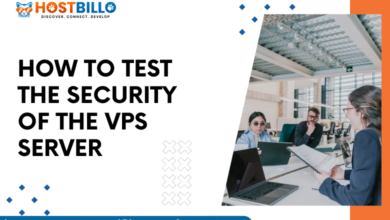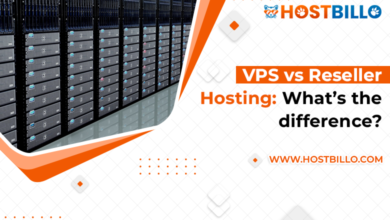How to Host a SaaS Application on a VPS Server?

Introduction
In the dynamic landscape of technology, hosting a Software as a Service (SaaS) application on a Virtual Private Server (VPS) has become an increasingly popular choice for businesses and developers alike. This blog aims to guide you through the process of hosting a SaaS application on a VPS server, unraveling the intricacies involved and providing practical insights for a seamless hosting experience.
Meaning of SaaS?
Software as a Service, commonly known as SaaS, refers to a cloud computing model in which software applications are sent over the World Wide Web according to the subscription. Contrary to traditional software installations, SaaS takes away the necessity for users to install, administer, and handle the software on their devices. Rather, users get the accessibility to the application via a web browser, enjoying the convenience of remote accessibility and automatic updates. Prevalent instances of SaaS applications incorporate CRM tools, project management software, & collaboration platforms.
VPS Hosting for SaaS Applications: How Does It Work?
Virtual Private Server (VPS) hosting serves as a powerful solution that offers several advantages when hosting SaaS applications. Let’s delve deeper into how this process works and why it’s a preferred choice for many:
Resource Allocation:
VPS hosting allocates dedicated resources such as CPU, RAM, and storage to each virtual machine, ensuring that the SaaS application operates with consistent performance levels. This resource isolation prevents any interference from other users who share the same physical web server.
Enhanced Control:
Users have greater administration over the server platform. This includes the ability to customize server settings, install specific software dependencies, and configure security measures tailored to the SaaS application’s requirements. This kind of authority is specifically advantageous for applications with distinct dependencies and security protocols.
Isolation and Security:
The VPS functions as an isolated virtual machine within a physical server, creating a secure environment for hosting the SaaS application. This isolation minimizes the risk of security breaches and provides a level of data protection crucial for sensitive applications handling user information.
Scalability:
VPS hosting allows for easy scalability by enabling users to adjust resources based on the evolving needs of the SaaS application. Whether it’s an increase in user traffic or additional features, the flexibility to scale up resources ensures that the application can handle varying workloads without compromising performance.
Cost Feasibility:
Relative to dedicated web servers, VPS hosting is a cost-effective solution for hosting SaaS applications. Users benefit from dedicated resources without the hefty price tag, making it an attractive option for startups and small to medium-sized businesses looking to optimize their budgets while maintaining high-performance standards.
Enhancing the Performance and Scalability of the Virtual Private Server
To guarantee optimal functioning as well as scalability for your SaaS application on a VPS server, a meticulous strategy is indispensable. Here, we delve into key pointers with additional insights to meticulously optimize the operation of your hosted application:
Caching Mechanisms:
Server-Side Caching: Implement robust server-side caching mechanisms to store frequently accessed data closer to the server. This minimizes the need for repeated requests. Consequently, you get quicker response times & diminished load on the server.
Content Caching Solutions: Explore advanced content caching solutions tailored to your SaaS application. Employing technologies such as Redis or Memcached can considerably enhance data retrieval speeds and overall user experience.
Content Delivery Networks (CDNs):
Strategic Distribution: Integrate a Content Delivery Network (CDN) into your hosting architecture for global reach. CDNs strategically position servers worldwide, allowing static content like images and stylesheets to be served from servers geographically closer to users, thus minimizing latency.
Performance Boost: Leverage CDNs for enhanced performance by offloading static content delivery to geographically optimized servers. This accelerates content delivery as well as assures a consistent & speedy end-user experience across diverse locations.
Efficient Database Management:
Query Optimization: Optimize database queries by fine-tuning them for efficiency and speed. Regularly review and refine queries to ensure they retrieve necessary data with minimal impact on server resources.
Indexing Strategies: Implement effective indexing strategies to expedite data retrieval processes. Well-placed indexes enhance database functioning, specifically in scenarios where complicated queries are implemented often.
Database Caching: Consider implementing database caching mechanisms to diminish the load on the database web server. Caching frequently accessed database queries or results can considerably intensify the data retrieval speed.
Resource Monitoring and Management:
Comprehensive Monitoring Tools: Employ comprehensive monitoring elements that render real-time peek into server resources. Monitor CPU usage, memory consumption, and storage capacity to identify potential bottlenecks and trends.
Proactive Adjustments: Engage in proactive resource management by analyzing monitoring data. Identify patterns that indicate increased demand or potential performance issues, allowing for timely adjustments to prevent downtime and maintain optimal performance.
Vertical Scaling:
Resource Upgrades: Evaluate vertical scaling options by upgrading resources on the existing VPS server. This may involve increasing CPU capacity, RAM, or storage based on the evolving demands of the SaaS application.
Quick Performance Enhancement: Vertical scaling offers a swift and efficient means of enhancing performance without necessitating significant architectural changes. It’s an ideal solution for addressing immediate resource demands.
Horizontal Scaling:
Multi-Server Deployment: Consider horizontal scaling for long-term scalability goals. Introduce additional VPS servers to your infrastructure, distributing the load of applications across numerous servers.
Load Balancing Mechanisms: Execute load balancing mechanisms to equally divide traffic among various web servers. This not only enhances performance but also establishes fault tolerance by eliminating the risk of a single point of failure.
A Guide to Finding a Good VPS Server Provider for a SaaS Application
Choosing the right VPS server provider is a critical step in ensuring the success and efficiency of your SaaS application. Here’s an in-depth guide with additional pointers to help you navigate through the selection process:
Server Reliability:
- Prioritize providers with a proven track record of server reliability. Look for guarantees such as high uptime rate & minimized downtime situations.
- Check for redundancy measures, like backup power sources and data replication, to ensure continuous operation even in the face of unexpected events.
Data Center Locations:
- Evaluate the geographical sites of the host’s data centers. Opt for a VPS provider with data centers strategically distributed worldwide.
- Proximity to target audiences can impact latency and, consequently, the overall performance of your SaaS application. Pick a web host with data centers near your user base for optimal speed.
Customer Support:
- Evaluate the quality as well as the responsiveness of the services of customer assistance. Look for providers offering 24/7 customer assistance via diverse channels like live chat, phone, etc.
- Inquire about the provider’s support policies, response times, and the proficiency of their team in administering technical issues related to SaaS application hosting.
Pricing Models and Transparency:
- Understand the pricing models offered by VPS providers. Compare costs based on resource allocation, additional features, and any potential hidden fees.
- Opt for providers with transparent pricing structures, clearly outlining the costs associated with different service levels. This helps in budget planning and avoiding unexpected expenses.
Scalability Choices:
- Take into account the scalability choices rendered by the VPS provider. Ensure that they offer easy and flexible scaling, allowing you to adjust resources as your SaaS application grows.
- Evaluate both vertical scaling (to upgrade web resources on the existing web server) and horizontal scaling (to add more web servers) options to accommodate increased demand and evolving requirements.
Security Measures:
- Pick providers with resilient protection features. Look for features such as firewalls, DDoS protection, and regular security updates.
- Inquire about the provider’s data protection policies, backup procedures, and any additional security tools or protocols they offer to safeguard your SaaS application and user data.
User-Friendly Interfaces:
- Assess the user interface and control panel rendered by the VPS web host. A human-friendly interface streamlines server management activities, making it easier to configure settings and monitor performance.
- Consider providers that offer intuitive interfaces, facilitating seamless navigation and efficient administration of your hosted SaaS application.
Community and User Reviews:
- Engage with online communities, forums, & review platforms to collect information from other users. Examine both positive and negative experiences to make an informed decision.
- Look for providers with an active and supportive user community, as this often indicates a reliable and user-friendly hosting environment.
Trial Periods & Money-Back Guarantees:
- Opt for web hosts that provide trial periods or money-back assurance. This allows you to test the services firsthand and assess their compatibility with your SaaS application before committing long-term.
- Make sure to read the terms & conditions of these guarantees to ensure a risk-free evaluation period.
Performance Metrics and Benchmarks:
- Review performance metrics and benchmarks provided by the VPS hosting provider. Evaluate factors such as server response times, network latency, and overall system performance.
- Consider running performance tests on the provider’s infrastructure to gauge how well it meets the specific requirements of your SaaS application.
Also Read: Dedicated Server: The Best Hosting Solution for Large Enterprises
Conclusion
Hosting a SaaS application on a VPS server demands a thoughtful approach, encompassing the understanding of SaaS principles, selecting an appropriate VPS provider, and implementing performance optimization strategies. By following the guidelines outlined in this blog, you can embark on a successful journey to host your SaaS application, ensuring reliability, scalability, and efficient performance in the digital realm.




